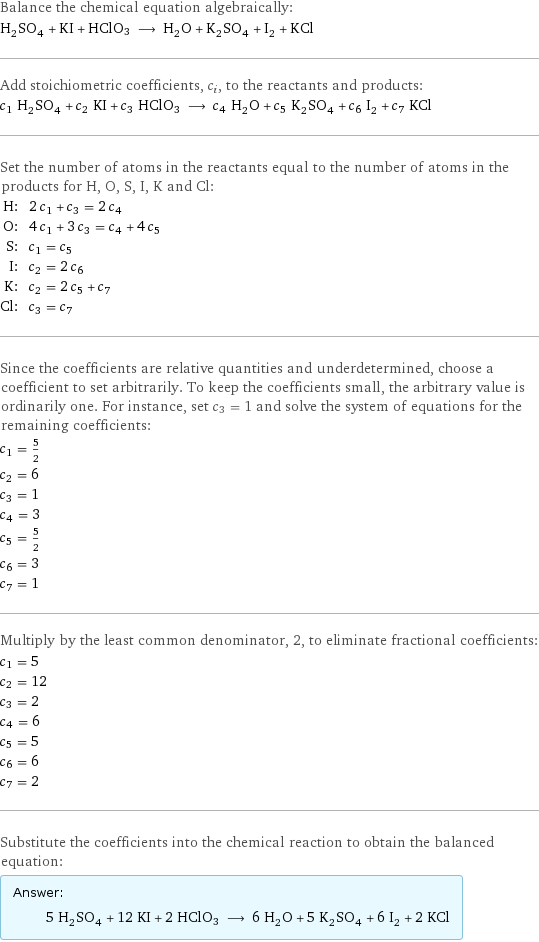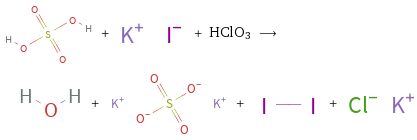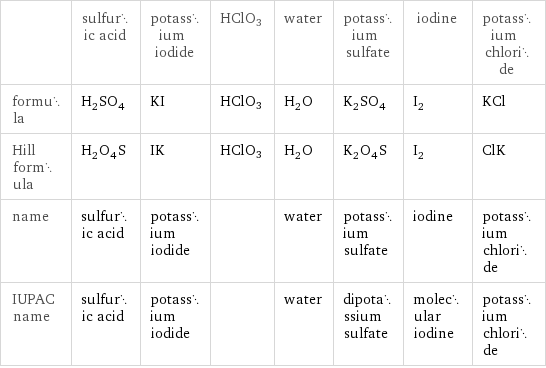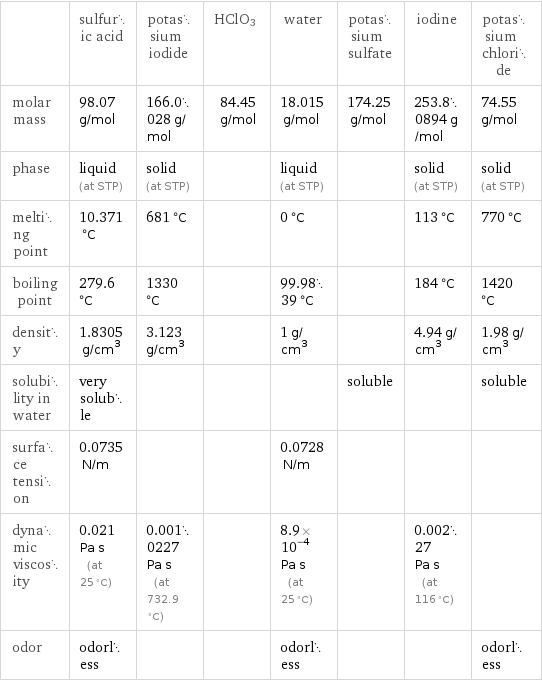Input interpretation

H_2SO_4 sulfuric acid + KI potassium iodide + HClO3 ⟶ H_2O water + K_2SO_4 potassium sulfate + I_2 iodine + KCl potassium chloride
Balanced equation

Balance the chemical equation algebraically: H_2SO_4 + KI + HClO3 ⟶ H_2O + K_2SO_4 + I_2 + KCl Add stoichiometric coefficients, c_i, to the reactants and products: c_1 H_2SO_4 + c_2 KI + c_3 HClO3 ⟶ c_4 H_2O + c_5 K_2SO_4 + c_6 I_2 + c_7 KCl Set the number of atoms in the reactants equal to the number of atoms in the products for H, O, S, I, K and Cl: H: | 2 c_1 + c_3 = 2 c_4 O: | 4 c_1 + 3 c_3 = c_4 + 4 c_5 S: | c_1 = c_5 I: | c_2 = 2 c_6 K: | c_2 = 2 c_5 + c_7 Cl: | c_3 = c_7 Since the coefficients are relative quantities and underdetermined, choose a coefficient to set arbitrarily. To keep the coefficients small, the arbitrary value is ordinarily one. For instance, set c_3 = 1 and solve the system of equations for the remaining coefficients: c_1 = 5/2 c_2 = 6 c_3 = 1 c_4 = 3 c_5 = 5/2 c_6 = 3 c_7 = 1 Multiply by the least common denominator, 2, to eliminate fractional coefficients: c_1 = 5 c_2 = 12 c_3 = 2 c_4 = 6 c_5 = 5 c_6 = 6 c_7 = 2 Substitute the coefficients into the chemical reaction to obtain the balanced equation: Answer: | | 5 H_2SO_4 + 12 KI + 2 HClO3 ⟶ 6 H_2O + 5 K_2SO_4 + 6 I_2 + 2 KCl
Structures

+ + HClO3 ⟶ + + +
Names

sulfuric acid + potassium iodide + HClO3 ⟶ water + potassium sulfate + iodine + potassium chloride
Equilibrium constant
![K_c = ([H2O]^6 [K2SO4]^5 [I2]^6 [KCl]^2)/([H2SO4]^5 [KI]^12 [HClO3]^2)](../image_source/77050eb6644a345498bb0fbce9c917d7.png)
K_c = ([H2O]^6 [K2SO4]^5 [I2]^6 [KCl]^2)/([H2SO4]^5 [KI]^12 [HClO3]^2)
Rate of reaction
![rate = -1/5 (Δ[H2SO4])/(Δt) = -1/12 (Δ[KI])/(Δt) = -1/2 (Δ[HClO3])/(Δt) = 1/6 (Δ[H2O])/(Δt) = 1/5 (Δ[K2SO4])/(Δt) = 1/6 (Δ[I2])/(Δt) = 1/2 (Δ[KCl])/(Δt) (assuming constant volume and no accumulation of intermediates or side products)](../image_source/77a4815a50cea4048a7a4ac1f4e63b54.png)
rate = -1/5 (Δ[H2SO4])/(Δt) = -1/12 (Δ[KI])/(Δt) = -1/2 (Δ[HClO3])/(Δt) = 1/6 (Δ[H2O])/(Δt) = 1/5 (Δ[K2SO4])/(Δt) = 1/6 (Δ[I2])/(Δt) = 1/2 (Δ[KCl])/(Δt) (assuming constant volume and no accumulation of intermediates or side products)
Chemical names and formulas

| sulfuric acid | potassium iodide | HClO3 | water | potassium sulfate | iodine | potassium chloride formula | H_2SO_4 | KI | HClO3 | H_2O | K_2SO_4 | I_2 | KCl Hill formula | H_2O_4S | IK | HClO3 | H_2O | K_2O_4S | I_2 | ClK name | sulfuric acid | potassium iodide | | water | potassium sulfate | iodine | potassium chloride IUPAC name | sulfuric acid | potassium iodide | | water | dipotassium sulfate | molecular iodine | potassium chloride
Substance properties

| sulfuric acid | potassium iodide | HClO3 | water | potassium sulfate | iodine | potassium chloride molar mass | 98.07 g/mol | 166.0028 g/mol | 84.45 g/mol | 18.015 g/mol | 174.25 g/mol | 253.80894 g/mol | 74.55 g/mol phase | liquid (at STP) | solid (at STP) | | liquid (at STP) | | solid (at STP) | solid (at STP) melting point | 10.371 °C | 681 °C | | 0 °C | | 113 °C | 770 °C boiling point | 279.6 °C | 1330 °C | | 99.9839 °C | | 184 °C | 1420 °C density | 1.8305 g/cm^3 | 3.123 g/cm^3 | | 1 g/cm^3 | | 4.94 g/cm^3 | 1.98 g/cm^3 solubility in water | very soluble | | | | soluble | | soluble surface tension | 0.0735 N/m | | | 0.0728 N/m | | | dynamic viscosity | 0.021 Pa s (at 25 °C) | 0.0010227 Pa s (at 732.9 °C) | | 8.9×10^-4 Pa s (at 25 °C) | | 0.00227 Pa s (at 116 °C) | odor | odorless | | | odorless | | | odorless
Units
